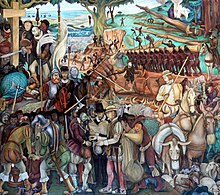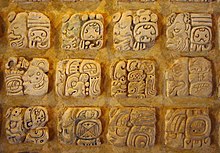Mexicans: Difference between revisions
m robot Modifying: es:Mexicanos mestizos |
Ocelotl10293 (talk | contribs) |
||
| Line 3: | Line 3: | ||
{{Infobox Ethnic group |
{{Infobox Ethnic group |
||
|group = Mexicans <br />"''Mexicanos''" |
|group = Mexicans <br />"''Mexicanos''" |
||
|image = [[File:Dolores del Rio Argentinean Magazine AD.jpg|70px]][[File:General Emiliano Zapata.jpg|60px]][[File:Octavio Paz.gif|63px]][[File:Benito Juarez Presidente.jpg|70px]][[File:Porfirio Diaz in uniform.jpg|66px]][[File:Frida Kahlo (self portrait).jpg|68px|Frida Kahlo]][[File:Mexico.RodolfoNeriVela.01.jpg|69px]][[File:MARIA SABINA.jpg|62px]][[File:Ramon novarro 2.jpg|68px]]<br>[[File:Motecuzoma Xocoyotzin.jpeg|66px]][[File:Lila Downs.jpg|68px]][[File:Carlos Fuentes.jpg|66px]][[File:Jorge Negrete.gif|66px]][[File:Juana Inés de la Cruz.jpg|69px|Juana Inés de la Cruz]][[File: |
|image = [[File:Dolores del Rio Argentinean Magazine AD.jpg|70px]][[File:General Emiliano Zapata.jpg|60px]][[File:Octavio Paz.gif|63px]][[File:Benito Juarez Presidente.jpg|70px]][[File:Porfirio Diaz in uniform.jpg|66px]][[File:Frida Kahlo (self portrait).jpg|68px|Frida Kahlo]][[File:Mexico.RodolfoNeriVela.01.jpg|69px]][[File:MARIA SABINA.jpg|62px]][[File:Ramon novarro 2.jpg|68px]]<br>[[File:Motecuzoma Xocoyotzin.jpeg|66px]][[File:Lila Downs.jpg|68px]][[File:Carlos Fuentes.jpg|66px]][[File:Jorge Negrete.gif|66px]][[File:Juana Inés de la Cruz.jpg|69px|Juana Inés de la Cruz]][[File:Marco rito.jpg|69px|Marco Rito-Palomares]] |
||
|caption = <small> Pictured: <br/> [[Dolores Del Rio]]{{·}}[[Emiliano Zapata]]{{·}}[[Octavio Paz]]{{·}}[[Benito Juárez]]{{·}}[[Porfirio Diaz]]{{·}}[[Frida Kahlo]]<br/>[[Rodolfo Neri Vela]]{{·}}[[Maria Sabina]]{{·}}[[Ramón Novarro]]<br>{{·}}[[Moctezuma II]]{{·}}[[Lila Downs]]{{·}}[[Carlos Fuentes]]{{·}}[[Jorge Negrete]]{{·}}[[Juana Ines de la Cruz]]{{·}}[[ |
|caption = <small> Pictured: <br/> [[Dolores Del Rio]]{{·}}[[Emiliano Zapata]]{{·}}[[Octavio Paz]]{{·}}[[Benito Juárez]]{{·}}[[Porfirio Diaz]]{{·}}[[Frida Kahlo]]<br/>[[Rodolfo Neri Vela]]{{·}}[[Maria Sabina]]{{·}}[[Ramón Novarro]]<br>{{·}}[[Moctezuma II]]{{·}}[[Lila Downs]]{{·}}[[Carlos Fuentes]]{{·}}[[Jorge Negrete]]{{·}}[[Juana Ines de la Cruz]]{{·}}[[Marco Rito-Palomares]]{{·}}</small> |
||
|population = '''World'''<br>'''±120,000,000''' |
|population = '''World'''<br>'''±120,000,000''' |
||
|langs = [[Spanish language|Spanish]], [[English language|English]] and 62 indigenous linguistic groups of [[Amerindian languages]]. |
|langs = [[Spanish language|Spanish]], [[English language|English]] and 62 indigenous linguistic groups of [[Amerindian languages]]. |
||
Revision as of 08:40, 12 August 2010
  File:Octavio Paz.gif File:Octavio Paz.gif    File:MARIA SABINA.jpgFile:Ramon novarro 2.jpg File:MARIA SABINA.jpgFile:Ramon novarro 2.jpg   File:Jorge Negrete.gif File:Jorge Negrete.gif Marco Rito-Palomares Marco Rito-Palomares | |
| Total population | |
|---|---|
| World ±120,000,000 | |
| Regions with significant populations | |
| 9,900,000 a[2] | |
| ~36,225 - 50,000 b[3] | |
| ~14,399 - 16,000 c[4] | |
| ~11,481 - 14,000[5] | |
| ~9,377 - 10,000[6] | |
| ~8,848 - 12,000[7] | |
| ~6,750 - 8,000[8] | |
| ~5,125 - 6,000 d[9] | |
| ~4,601 - 6,000[10] | |
| 4.252[11] | |
| 3.485[12] | |
| ~3.075 - 4,000[13] | |
| 2.349[14] | |
| Languages | |
| Spanish, English and 62 indigenous linguistic groups of Amerindian languages. | |
a Chicano, Mexican American b Mexican Canadian | |
Mexican people (Spanish: Mexicanos) refers to all persons who identify with the Mexican cultural and/or national identity.
Mexico became a nation in 1821 when Mexico achieved independence from the Spanish Empire, this began the process of forging a Mexican national identity that fused the cultural traits of indigenous pre-columbian origin with those of the dominant group of European, particularly Iberian, ancestry. This led to what has been termed "a peculiar form of multi-ethnic nationalism"[15]
The most spoken language by Mexicans is Mexican Spanish, but many also speak languages from 62 different indigenous linguistic groups and other languages brought to Mexico by recent immigration or learned by Mexican immigrants residing in other nations. The majority of Mexicans live in Mexico but there is a sizable diaspora, especially in the United States and Canada.
History
This section needs expansion. You can help by adding to it. (January 2010) |
The Mexican people have varied origins and an identity that has evolved with the succession of conquests among Amerindian groups and by Europeans. The area that is now modern-day Mexico has cradled many predecessor civilizations, going back as far as the Olmec which influenced the latter civilizations of Teotihuacan (200 B.C. to 700 A.D.) and the much debated Toltec people who flourished around the 10th and 12th centuries A.D., and ending with the last great indigenous civilization before the Spanish Conquest, the Aztecs (March 13, 1325 to August 13, 1521). The Nahuatl language was a common tongue in the region of modern Central Mexico during the Aztec Empire, but after the arrival of Europeans the common language of the region became Spanish.
After the conquest of the Aztec empire, the Spanish re-administered the land and expanded their own empire beyond the former boundaries of the Aztec, adding more territory to the Mexican sphere of influence which remained under the Spanish Crown for 300 years. Cultural diffusion and intermixing among the Amerindian populations with the European created the modern Mexican identity which is a mixture of regional indigenous and European cultures that evolved into a national culture during the Spanish Colonial period. This new identity was defined as "Mexican" shortly after the Mexican War of Independence and was more invigorated and developed after the Mexican Revolution when the Constitution of 1917 officially established Mexico as an indivisible pluricultural nation founded on its indigenous roots.
Definitions
This section needs expansion. You can help by adding to it. (January 2010) |
Mexicano (Mexican) is derived from the word Mexico itself. In the principal model to create demonyms in Spanish, the suffix -ano its added to the name of the place of origin. The term Mexicano as a word to describe the different peoples of the region of Mexico as a single group emerged in the 16th century. In that time the term did not apply to a nationality nor to the geographical limits of the modern Mexican Republic. The term was used for the first time in the first document printed in Barcelona in 1566 which documented the expedition which launched from the port in Acapulco to find the best route which would favor a return journey from the Spanish East Indies to New Spain. The document stated: "el venturoso descubrimiento que los Mexicanos han hecho" (the venturous discovery that the Mexicans have made). That discovery led to the Manila galleon trade route and those "Mexicans" referred to Criollos, Mestizos and Amerindians alluding to a plurality of persons who participated for a common end: the conquest of the Philippines in 1565. (Gómez M., et al. 56)
Mexican racial groups
Judging Mexicans based on racial classification is never precise or accurate due to the various standards of measurement employed in classification which are often based on ambiguous standards and definitions. The percentages will inevitably overlap when comparing different sources because through some standards of classification certain individuals can classify in one group while in another study with different criteria they would be classified under another group.
Certain things are known for certain when one employs interdisciplinary standards ranging from historical accounts to genetic studies. The Mexican National Institute of Genomic Medicine recently conducted research into mapping certain genetic markers that are found in the Mexican population. Their studies, along with other sources, have revealed that Mexicans are indeed racially diverse with about 80% being Mestizos and having approximately even admixture of Native American and European heritage.[16] Some Mexicans of mixed descent also have a very small amount of African blood, with the most significant amount being found in southern central Mexico. Mexicans of East Asian descent are also very low in number, but can be found in significant levels in Baja California, especially Mexicali, as well as a select few other parts of Mexico.[17] Some researchers, however, also believe that there are no "pure races" among the ethnically Mexican population,[18] that is to say, among Mexicans who are Mexican by heredity excluding recent immigrants who have been naturalized as Mexican citizens.
Mestizos

Mestizos are those who have a mixed ancestry between Europeans and Amerindians within the Mexican context discarding the other definitions that this term may be used for under other settings. Mestizos make up the largest racial identity among Mexicans comprising more than 80% of the population, as stated above.[16]
Indigenous



Various estimates claim between 10%-30% of Mexicans are indigenous peoples (indígenas).[19][20][1][17][21] To be classified as indigenous under the Mexican government's standards they use a political, linguistic and cultural criteria to judge whether or not the indigenous people still retain their traditional cultures and languages as well as their political autonomy within the Mexican national territory.
The 2nd Article of the Mexican constitution gives the criterion for the classification of indigenous people:[22]
"The Mexican nation is one and indivisible. The nation has a multicultural composition originally based on its indigenous peoples who are those who descend from the populations that inhabited the territory of the present nation at the beginning of the colonization and who still retain their own social, economic, cultural and political identity or part thereof. The awareness of their indigenous identity should be the fundamental criterion for determining to whom the provision of indigenous peoples applies. Those communities that are members of an indigenous people are those who form a social, economic and cultural unit of development and is established in a certain territory and who recognize their own authorities in accordance with their own customs."
When this strictly cultural/political method of classification is used the number of people classified as indigenous drops, but when racial/genetic factors are included and cultural affiliation is disregarded, as it's often done by foreign observers and researchers, the number increases. Despite the high esteem in which the indigenous people are held in the mainstream consensus, and their importance to the foundation of Mexico's identity as a pluricultural nation,[22] the indigenous peoples are still the most marginalized group which has resulted in various revolts such as the Zapatista Rebellion and the Caste War of Yucatán.
Europeans
It is estimated that 9-17% of Mexicans identify themselves or are classified as Criollos, or "White Mexicans".[1][17][21][23] Some Criollos still retain and/or identify more with European cultures and customs while others practice more local customs and traditions. The northern regions of Mexico, such as the states of Chihuahua and Nuevo León particularly the city of Monterrey[citation needed], hold the greatest European genetic admixture with roughly 50-61% European admixture among the regional mestizo population.[24] However with successive generations the population is becoming more homogenized with the indigenous population as more people from south and central Mexico move north and vice versa.[25][26]
Other
People groups other than Mestizos, Amerindians, and Europeans are less numerous in Mexico. About 1% or 1.8% of the Mexican population is of some black African descent, the great majority are mixed (mulattoes and zambos). These are mostly the descendants of slaves brought by the Spanish. Significant communities of Afro-Mexicans can be found in regions within the states of Guerrero and Veracruz. Those of East Asian decent make up less than approximately 1.5% of the populaion of Mexico.[27] Many Asian Mexicans are of Korean and Japanese descent. Others are of Filipino and Chinese descent due to the Acapulco-Manila trade wherein the Spaniards brought over people from Asia into Mexico. Large numbers of Chinese immigrated to Mexico but were forcibly deported out of the country during the presidency of Mexican president Plutarco Elías Calles. There are also large Chinatowns in Mexicali, Baja California. Arab Mexicans make up about 1% of the population.[28] Most Arab Mexicans come from Lebanon.
Languages
This section needs additional citations for verification. (July 2010) |

Mexicans are linguistically diverse, with many speaking European languages as well as various Indigenous Mexican Languages. Spanish is spoken by approximately 92.17% of Mexicans as their first language making them the largest Spanish speaking group in the world[29] followed by Colombia (45,273,925), Spain (41,063,259)[30] and Argentina (40,134,425).[citation needed] Although the great majority speak Spanish de facto the second most populous language among Mexicans is English due to the regional proximity of the United States which calls for a bilingual relationship in order to conduct business and trade as well as the migration of Mexicans into that country who adopt it as a second language.
Mexican Spanish is distinct in dialect, tone and syntax to the Peninsular Spanish spoken in Spain. It contains a large amount of loan words from indigenous languages, mostly from the Nahuatl language such as: "chocolate," "tomate," "mezquite," "chile," and "coyote".[31]
Mexico has no official de jure language,[32] but as of 2003 it recognizes 62 indigenous Amerindian languages as "national languages" along with Spanish which are protected under Mexican National law giving indigenous peoples the entitlement to request public services and documents in their native languages.[33] The law also includes other Amerindian languages regardless of origin, that is, it includes the Amerindian languages of other ethnic groups that are non-native to the Mexican national territory. As such, Mexico's National Commission for the Development of Indigenous Peoples recognizes the language of the Kickapoo who immigrated from the United States,[34] and recognizes the languages of Guatemalan Amerindian refugees.[35] The most numerous indigenous language spoken by Mexicans is Nahuatl which is spoken by 1.7% of the population in Mexico over the age of 5. Approximately 6,044,547 Mexicans (5.4%) speak an indigenous language according to the 2000 Census in Mexico.[36] There are also Mexicans living abroad which speak indigenous languages mostly in the United States but their number is unknown.[37]
The non-indigenous languages spoken in Mexico include English (by English-speaking immigrants, as well as by the residents of border states). One example of this group is the American Mormon colony of Nueva Casas Grandes in Chihuahua, which settled in the late 1800s. German (spoken mainly in Mexico City and Puebla), Arabic, Russian, Veneto (in Chipilo), French, Occitan, Catalan, Basque, Galician, Asturian, Chinese, Hebrew, Korean, Ladino, Plautdietsch, Armenian and other languages are spoken by smaller numbers.[citation needed] Some of these languages (such as Veneto, French and Plautdietsch) are spoken in isolated communities or villages.[which?] The rest are spoken by immigrants or their descendants who tend to live in the larger cities and towns. Many of these languages have significantly more speakers than those of indigenous language speakers in Mexico,[citation needed] such as German dialects, Italian dialects and French dialects, but they are not protected by law.
Gallery
-
Racial diversity in Mexican school children.
-
Indigenous Mexican girls.
-
Mexicans of Spanish descent.
-
Mennonites from northern Mexico.
-
Nordic Mexican girls.
-
Afro-Mexican of Costa Chica.
-
Women of Yucatec Mayan descent (Amerindian).
-
Mexican mestizos.
-
Mexicans of Chinese descent.
-
Caucasian Mexican.
-
Carlos Slim, Mexican of Arab (Lebanese) descent.
-
José Carlos Ruiz, Indigenous Mexican.
See also
- List of Mexicans
- Culture of Mexico
- History of Mexico
- Mexican literature
- Mexican nobility
- Indigenous Mexican
- Mestizo
- Afro-Mexican
- White Mexican
- Criollo
- Arab Mexican
- Asian Mexican
- Mexican American
- Mexicans in the United Kingdom
- Anti-Mexican sentiment
- Latin Americans
Works cited
Gómez M., et al. Historia de México: Texto de Consulta Para Educación Media Superior. Mexico: Limusa, 2006.
References
- ^ a b c CIA World Factbook - Mexico
- ^ conapo.gob.mx; Mexicanos en Estados Unidos
- ^ statcan.ca; Mexicanos en Canadá Censo de 2001
- ^ Mexicanos en España INE 2007
- ^ Investigación de la Migración Internacional en Latinoamérica (IMILA).
- ^ Bolivia - Censo de Población y Vivienda 2001
- ^ Statische Bundesamt Deutschland
- ^ Argentina - Población extrenjera residente en Argentina de 2000-2008
- ^ ime.gob.mx; Mexicanos en Reino Unido
- ^ INED France- INED
- ^ PERIOD OF IMMIGRATION, COUNTRY OF BIRTH AND LAST COUNTRY OF RESIDENCE IN ISRAEL 2008
- ^ Istat
- ^ INE
- ^ 2000 Housing and Population Census
- ^ Wimmer, Andreas, 2002. Nationalist exclusion and ethnic conflict: shadows of modernity, Cambridge University Press page 115
- ^ a b www.inmegen.gob.mx
- ^ a b c convergencia.uaemex.mx pp.12
- ^ Lisker R, Rameriz E, Gonzalez-Villapando C, Stern MP (1995) Racial admixture in a Mestizo population from Mexico City. Am J Hum Biol 7:213–216.
- ^ Pueblos Indígenas de México 2005, Comisión Nacional para el Desarrollo de los Pueblos Indígenas
- ^ Lizcano 2005:218 cuadro 2; Martínez-Torres et al. 2008:78; Navarrete Linares 2008:9
- ^ a b World Statesmen - Mexico
- ^ a b Mexican Constitution
- ^ Encyclopædia Britannica - Mexico - Ethnic groups
- ^ "Average ancestry proportions of 6 Mexican Mestizo subpopulations, Amerindian Zapotecos from Oaxaca, and all HapMap populations" (PDF). National Academy of Sciences. 2008. Retrieved 2010-07-26.
- ^ Cerda-Flores RM, Garza-Chapa R (1989) Variation in the gene frequencies of three generations of humans from Monterrey, Nuevo León, Mexico. Hum Biol 61:249–261
- ^ http://www.ncbi.nlm.nih.gov/pubmed/2767673
- ^ www.inmegen.gob.mx
- ^ WorldStatesmen.org - Mexico
- ^ Encyclopædia Britannica. "Spanish language - Britannica Online Encyclopedia". Britannica.com. Retrieved 2010-07-26.
{{cite web}}: CS1 maint: multiple names: authors list (link) - ^ www.ine.es Spanish population 2009
- ^ "Spanish Language History and Main Spanish-Speaking Countries". Todaytranslations.com. Retrieved 2010-07-26.
- ^ "Constitución Política De Los Estados Unidos Mexicanos" (PDF). Retrieved 2010-07-26.
- ^ "Microsoft Word - 257" (PDF). Retrieved 2010-07-26.
- ^ "Kikapúes — Kikaapoa". CDI México. Retrieved 2007-10-02.
- ^ "Aguacatecos, cakchiqueles, ixiles, kekchíes, tecos y quichés". CDI México. Retrieved 2007-10-02.
- ^ "Perfil sociodemográfico de la población hablante de náhuatl" (PDF). Retrieved 2010-07-26.
- ^ "Can a Mother Lose Her Child Because She Doesn't Speak English?". Time. August 27, 2009. Retrieved May 12, 2010.









